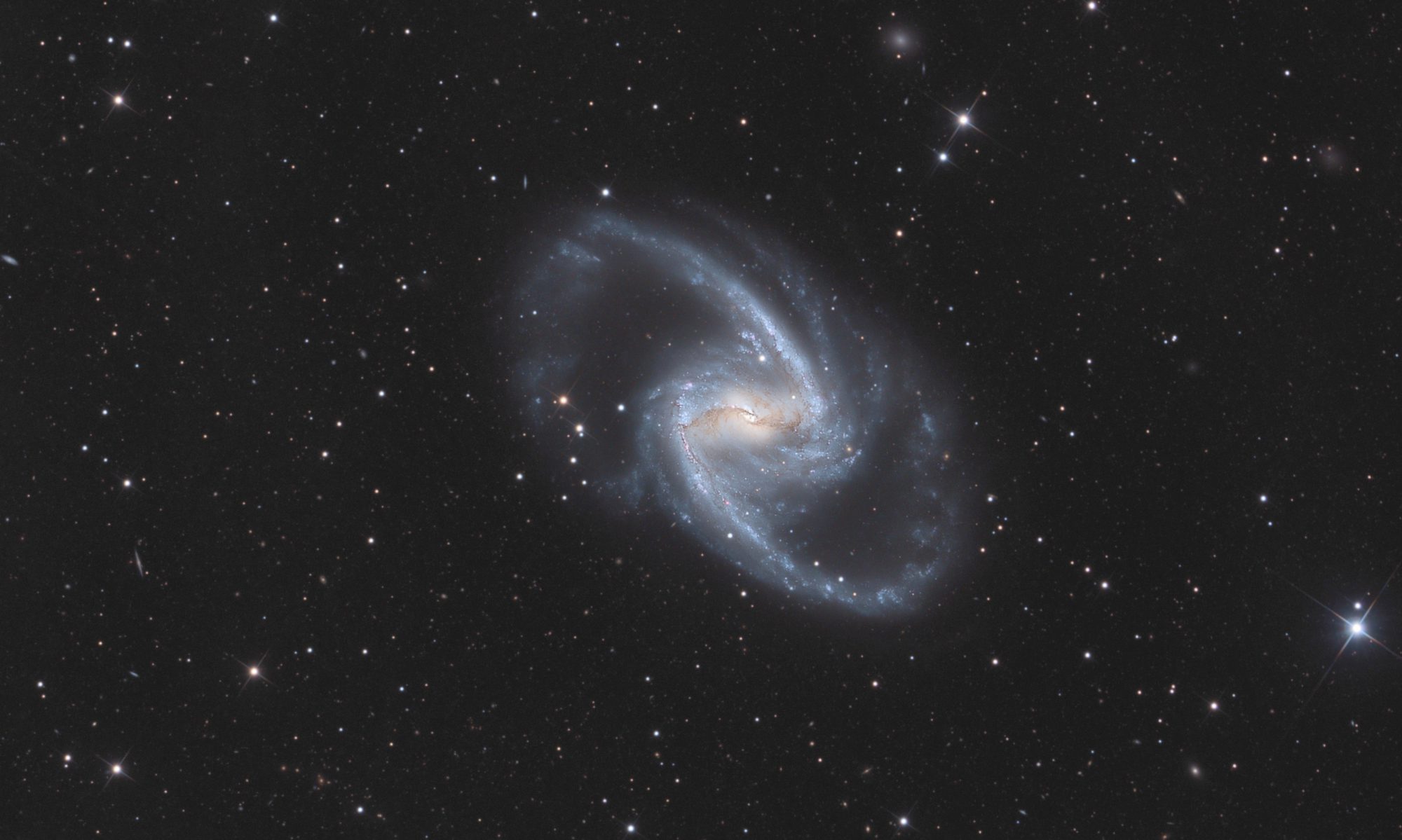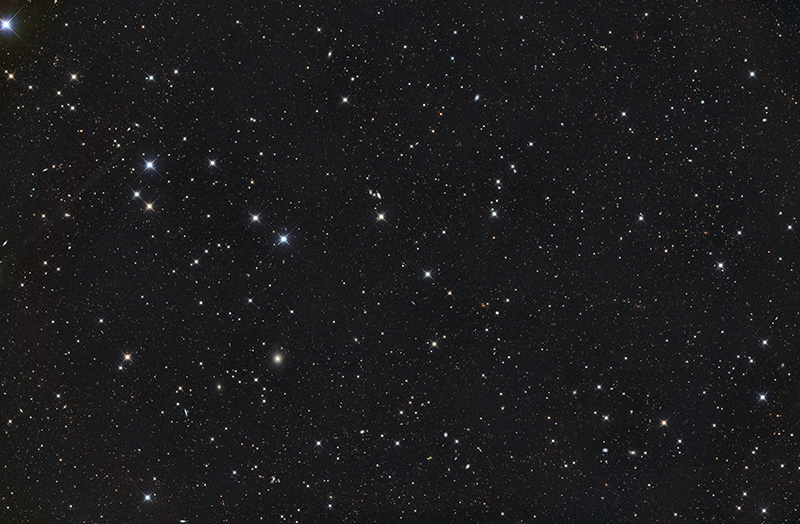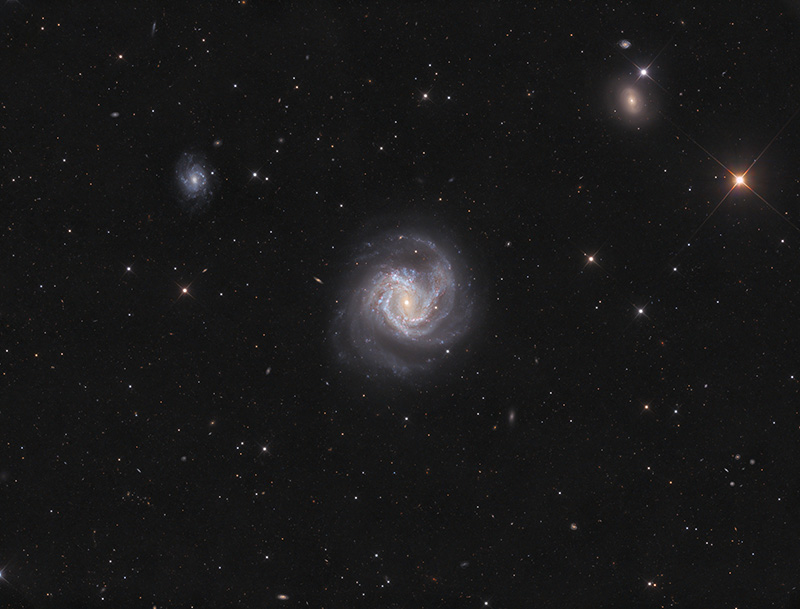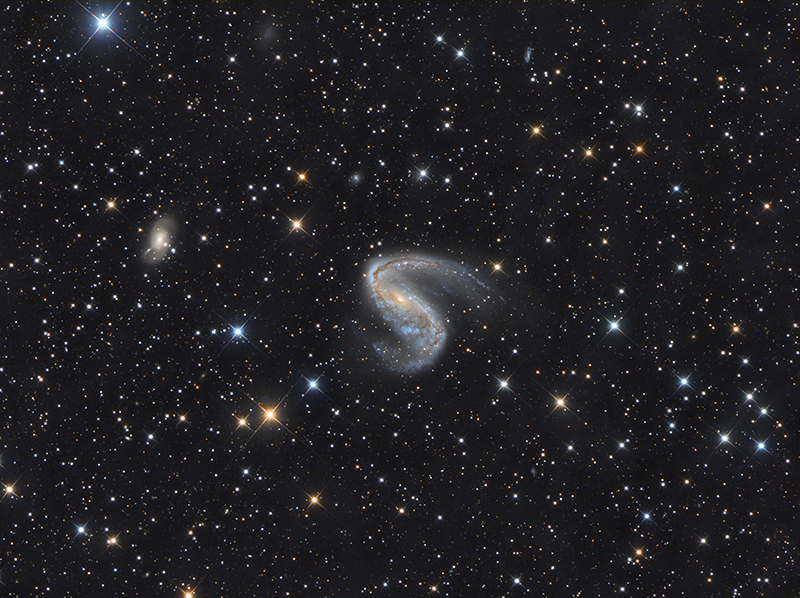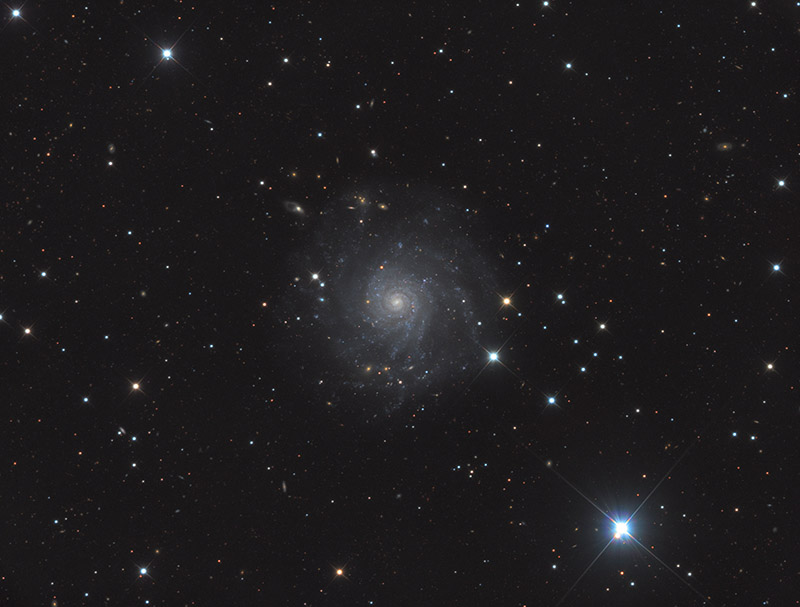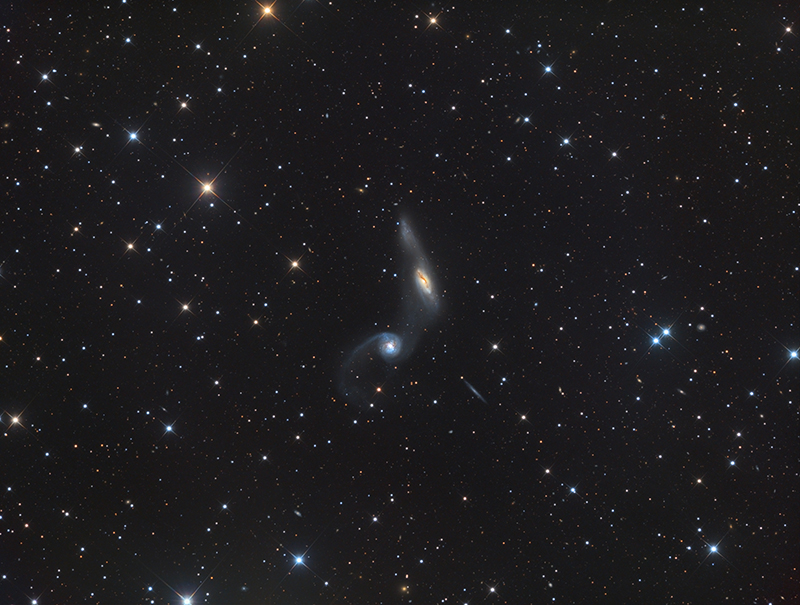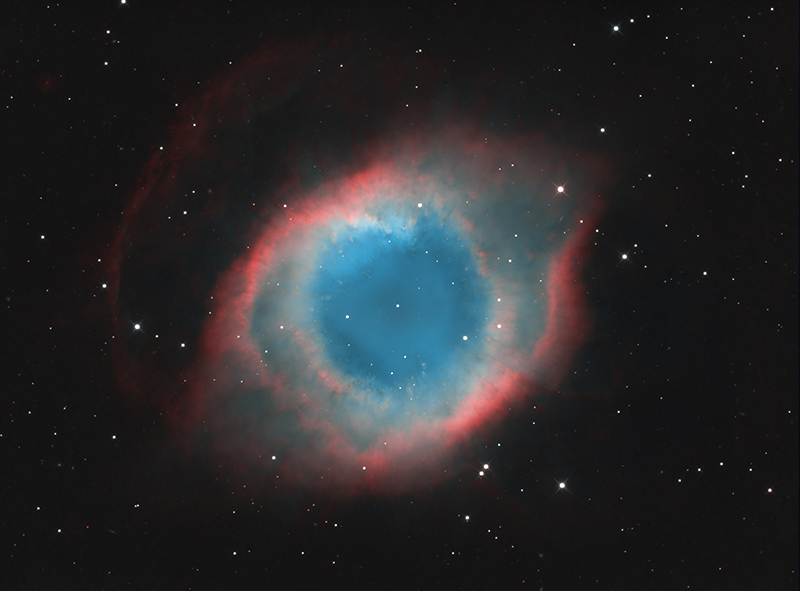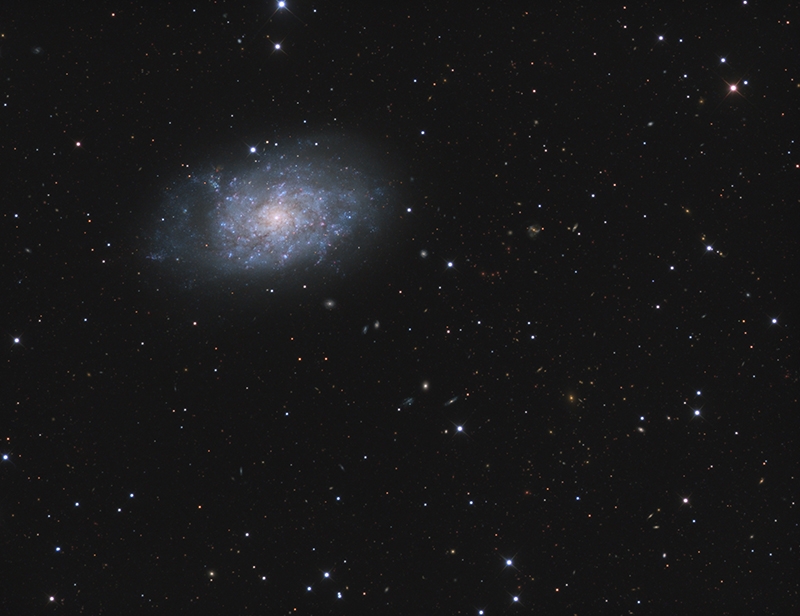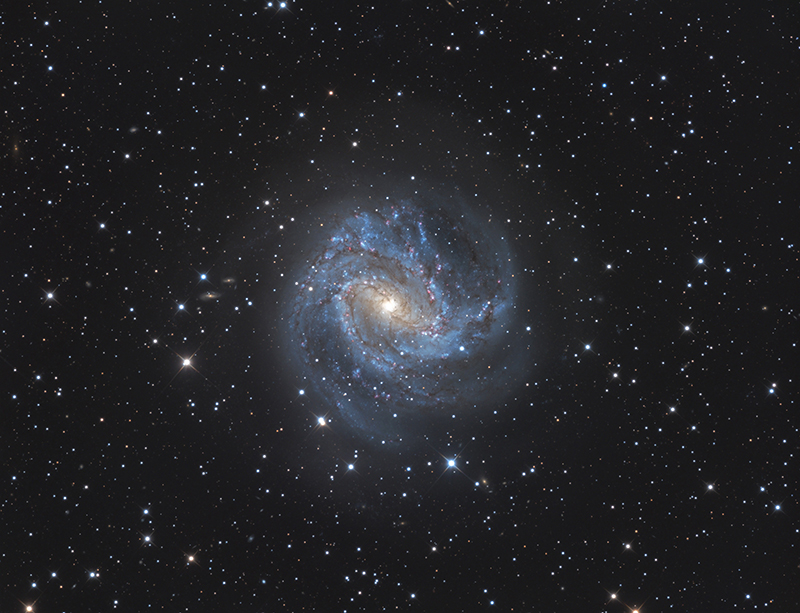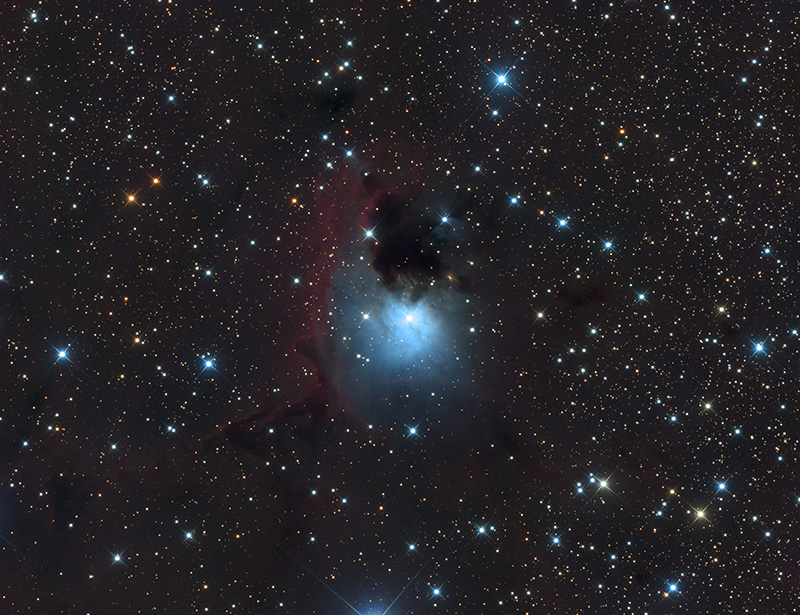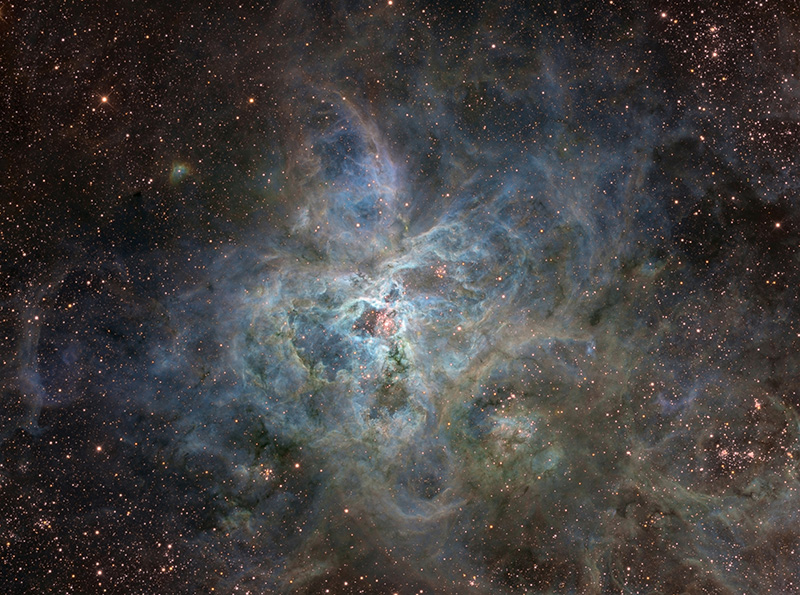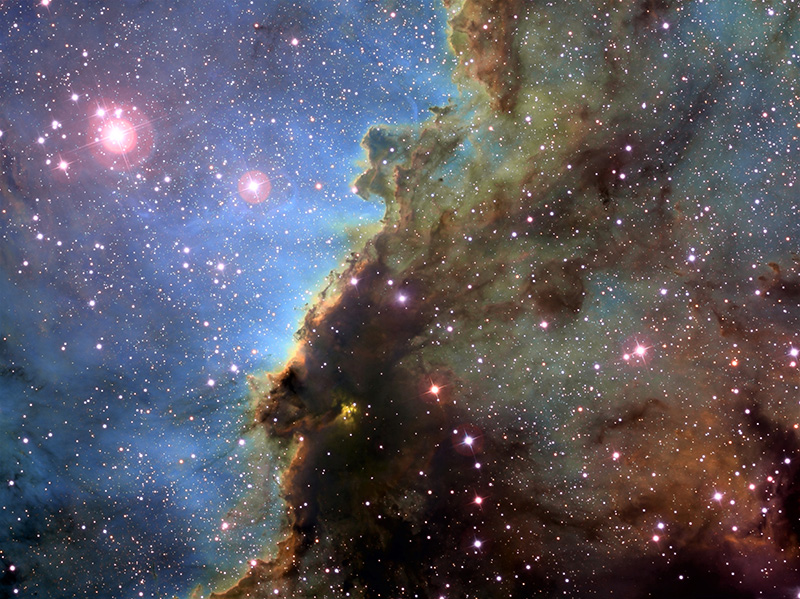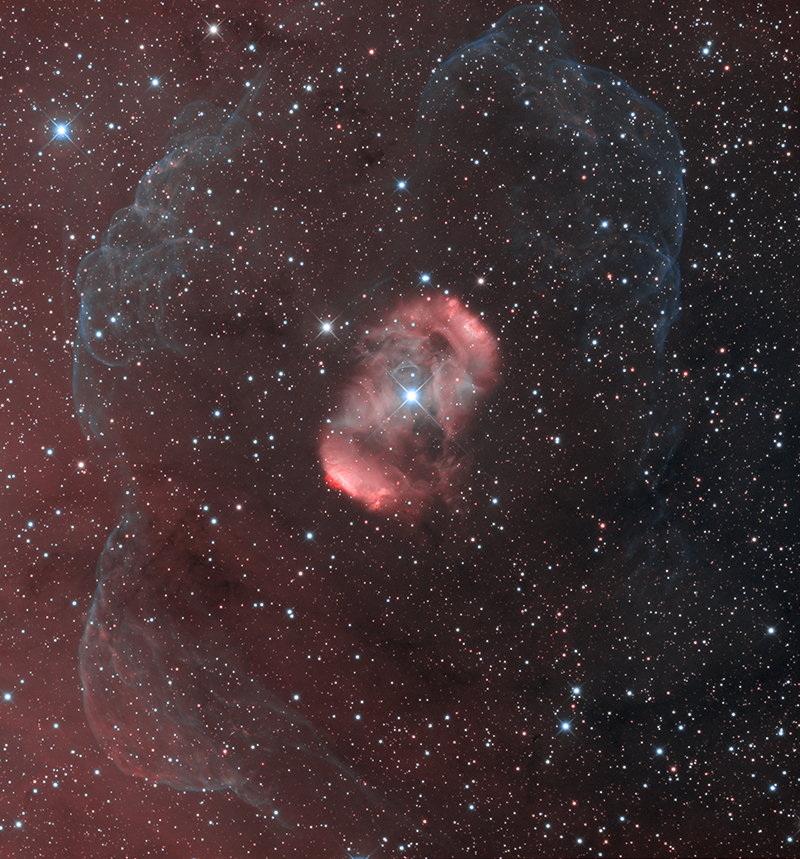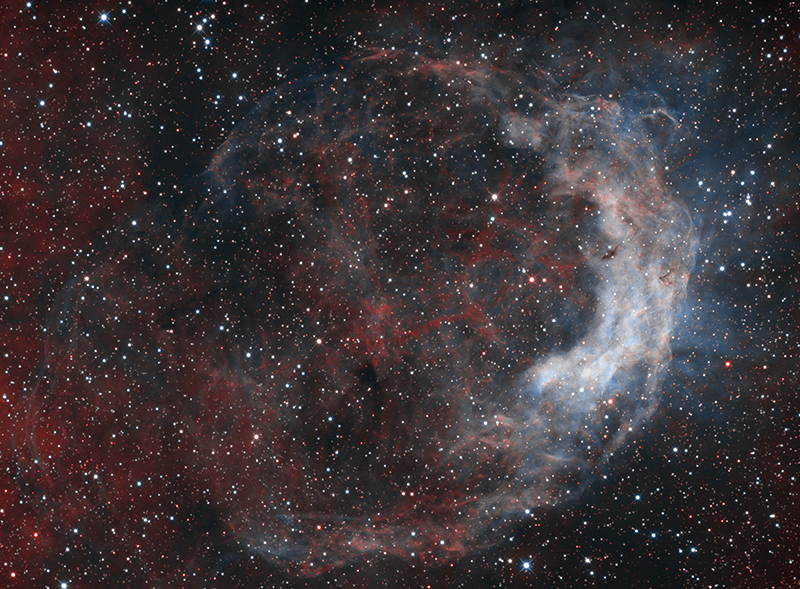G351.85+2.25
Click on the image to see it full size
G351.85+2.25 is a dark nebula in the constellation Scorpio, i.e. a collection of unlit gas and dust that obscures the stars in the background.
Technical characteristics: 12h05 exposure in total: 8h50 on the Luminance layer, and 1h05 per Red Green and Blue colour. Newton-type telescope 520mm diameter F/D=3.5, ZWO6200 camera, sampling of 0.4 arcsec per pixel.
Comments on the astrosurf page.
______________________________________________________________________
El Gordo
Click on the image to see it full size
El Gordo (the big one) is the largest known cluster of galaxies in the distant universe in the constellation Phoenix. It has been studied by the VLT telescopes, the Chandra Space Telescope and the Atacama Cosmological Telescope, and more recently by the James Webb Space Telescope (JWST). It is located 6.2 billion light years away. The background of the image is lined with thousands of galaxies
On the left zoom from the centre of the image, and on the right the same field on the JWST. Several gravitational arcs can be discerned (distorted images of distant galaxies whose light reaches us distorted and amplified by the curvature of space due to El Gordo). In particular in « 1 » « La Flaca » (the skinny one) galaxy located at 11 billion light years and in « 2 », « El Anzuelo » (the fishhook) galaxy at 10.6 billion light years.
Technical specifications: 41h50 exposure in total: 27h20 on the Luminance layer, and 4h50 per Red Green and Blue colour. Newton-type telescope 520mm diameter F/D=3.5, ZWO6200 camera, sampling of 0.4 arcsec per pixel.
Comments on the astrosurf page.
______________________________________________________________________
NGC6357
Click on the image to see it full size
NGC6357 is located in the constellation Scorpio about 5900 light years away.
NGC 6357 also known as the Lobster Nebula is an emission nebula, it contains several open clusters some of which are home to the most massive stars known.
In the centre the Pismis 24 cluster contains several massive stars, including Pismis 24-1. The luminosity of the latter reaches 776,000 times that of the Sun. This star was thought to be the most massive discovered, approaching 300 solar masses, but it has recently been shown to be a stellar system containing at least three stars. The mass of the system’s components, however, is of the order of 100 solar masses, making them the most massive stars known
Technical characteristics: mosaic of two images with, for each image, 30h of exposure in total: 10h on the Ha, SII and OIII layers. Newton-type telescope 520mm diameter F/D=3.5, ZWO6200 camera, sampling of 0.4 arcsec per pixel.
Comments on the astrosurf page.
______________________________________________________________________
RCW40-RCW39
Click on the image to see it full size
RCW40 and RCW39 are located in the constellation of the Veils about 5900 light years away.
The main (largest) nebula RCW40 or Gum25 is a luminous nebula consisting of a cloud of ionised gas that is illuminated by hot young stars nearby. RCW40 is thought to be one of the youngest H II regions in the Milky Way, with an estimated age of just 200,000 years.
The nebula is home to a number of massive young stars, including the star cluster NGC 3576. These stars are responsible for the intense radiation and stellar winds that shape the surrounding gas and dust into complex structures. One of the most important features of RCW40 is a large dark cloud known as Thackeray’s globules, which are thought to be collapsing to form new stars.
The planetary nebula G269.3-00.8 is visible completely to the left of the field and slightly higher than RCW39.
Technical specifications: 30h exposure in total: 10h on the Ha, SII and OIII layers. Newton-type telescope with 520mm diameter F/D=3.5, ZWO6200 camera, sampling of 0.4 arcsec per pixel.
The technical specifications.
Comments on the astrosurf page.
______________________________________________________________________
NGC3521
Click on the image to see it full size
NGC 3521 is an intermediate spiral galaxy located in the constellation Leo. Its velocity relative to the cosmological diffuse background is 1 167 ± 26 km/s, which corresponds to a Hubble distance of 17.21 ± 1.26 Mpc (∼56.1 millions of a.l.). NGC 3521 was discovered by the German-British astronomer William Herschel in 1784.
As NGC 3521’s spiral arms are uneven and discontinuous, it can be described as a cottony spiral galaxy. What’s more, this galaxy is surrounded by a gigantic bubble-shaped shell that has earned it the nickname Bubble Galaxy. This shell is thought to have been formed by debris and stars torn from satellite galaxies by NGC 3521’s gravity.
The luminosity class of NGC 3521 is II-III and it has a broad HI line. It also contains regions of ionised hydrogen. In addition, NGC 3521 is a LINER galaxy, i.e. a galaxy whose nucleus has an emission spectrum characterised by broad lines of weakly ionised atoms.
Technical specifications: 15h15 exposure in total: 10h on the Luminance layer, and 1h45 per Red Green and Blue colour. Newton-type telescope 520mm diameter F/D=3.5, ZWO6200 camera, sampling of 0.4 arcsec per pixel.
Comments on the astrosurf page.
______________________________________________________________________
SH2-311
Click on the image to see it full size
SH2-311 is located in the constellation of Poupe about 20,500 light years away.
SH2-311 is a nebula of stars nicknamed the « Skull and Crossbones nebula », with an appearance reminiscent of a mandrill’s face. It includes regions where large clouds of hydrogen gas act as incubators for stars. It is ionised by the ultra-hot stars O3 V HD 64568, O6 IV HD 64315, and B0 V LSS 830. In addition to the cluster NGC2467, it includes the two clusters Haffner 18 (centre) and Haffner 19 (centre right, in the blue area resembling the lowest eye of the mandrill) . The area around the star cluster NGC2467 is located to the south of the constellation La Poupe. With an age of just a few million years, it is a very active stellar nursery, with stars forming continuously from clouds of dust and gas. The bright star at the centre of the larger blue region at the bottom of the image is HD 64315, a massive young star helping to shape the structure of the entire nebula region.
Haffner 18 is actually the superposition of two clusters at different distances, one at 4500 parsecs and the other between 9500 and 11400 parsecs. Haffner 19 is at 6400 +/- 600 pc. This implies that only part of Haffner18 is related to the nebula.
The image shows different stages in star formation. The stars in the middle have already formed and their birth nebula has already dispersed. Below a little to the left is a very young star that has broken away from the cocoon of gas that surrounded it at birth (small circular yellow area). At the bottom right, a wall of bright gas glows as it evaporates due to the energy of the many bright stars that have just formed. Towards the centre, very dark bands of dust mask parts of the nebula, which is certainly forming new stars.
Technical specifications: 30h exposure in total: 10h on the Ha, SII and OIII layers. Newton-type telescope 520mm diameter F/D=3.5, ZWO6200 camera, sampling of 0.4 arcsec per pixel.
Comments on the astrosurf page.
______________________________________________________________________
SH2-308
Click on the image to see it full size
Sh2-308, also named Sharpless 308, RCW 11 and LBN 1052, is an emission nebula and HII region located a few thousand light-years (al) from Earth, near the centre of the constellation of the Great Dog, about 8 degrees south of the star Sirius.
Bubble-shaped, the nebula is about 60 al in diameter at its farthest ends. It surrounds the Wolf-Rayet type star EZ Canis Majoris.
The nebula is thought to have formed around 70,000 years ago by the ejection of the outer layers of the star EZ Canis Majoris. The bubble is shaped by the star’s strong stellar winds, which can reach ~ 1,700 km/s. The nebula is made up of hydrogen ionised by the star’s ultraviolet radiation.
Estimates of the nebula’s distance vary widely. For example, some authors speak of a distance of 1,875 al, others of 5,200 light-years, while some mention 5,870 al.
Technical characteristics: mosaic of 2 images of 40h exposure in total on each image: 20h on the Ha layer and 20h on the OIII layer. Newton-type telescope 520mm diameter F/D=3.5, ZWO6200 camera, sampling 0.4 arcsec per pixel.
Comments on the astrosurf page.
______________________________________________________________________
NGC1672
Click on the image to see it in full size
NGC1672 is a barred spiral galaxy located in the constellation Dorado. Its speed relative to the cosmological diffuse background is 1,348 ± 3 km/s, corresponding to a distance of ∼64.9 million a.l. It was discovered by Scottish astronomer James Dunlop in 1826.
The centre of the galaxy contains a central bar with high surface brightness. Four spiral arms extend outwards from the ends of this bar. These spiral arms are asymmetric. The arm in the north-eastern region is significantly brighter than the one opposite it. It is estimated that the length of the central bar of NGC 1672 is around 65,000 light-years. The spiral arms contain numerous star-forming regions.
The core of NGC1672 is Seyfert-like and is dotted with star-forming outburst regions. Both star-forming regions and an active core powered by a central black hole could be found here.
The technical features: the nucleus of NGC1672 is a Seyfert-type nucleus, dotted with star-forming regions.
Technical specifications: 15h05 exposure in total: 10h05 on the Luminance layer, and 1h40 per Red Green and Blue colour. Newton-type telescope 520mm diameter F/D=3.5, ZWO 1600 camera, sampling of 0.4 arcsec per pixel.
Comments on the astrosurf page.
______________________________________________________________________
NGC1313
Click on the image to see it full size
NGC1313 is a relatively close barred spiral galaxy located in the constellation Reticule. Its velocity relative to the cosmological diffuse background is 441 ± 3 km/s, corresponding to a Hubble distance of ∼21.2 million a.l. It was discovered by the Scottish astronomer James Dunlop in 1826.
The appearance of this galaxy suggests that it has had a troubled past. Its spiral arms are uneven and several globules of gas are present.
Many star-forming sites and several open clusters of young stars are present in the arms of this galaxy, as well as superbubbles associated with these stars. The radiation from these hot young stars floods the gas present in the galaxy creating lovely patterns of light and dark nebulae. NGC1313 is therefore a galaxy with bursts of star formation. NGC1313 presents one of the most enigmatic problems encountered by astronomers. In most star-forming galaxies, the high birth rate of stars is due to a close encounter or a merger of two galaxies. But strangely, NGC1313 appears to be a gravitationally isolated galaxy.
Technical characteristics: 18h10 exposure in total: 13h40 on the Luminance layer, and 1h30 per Red Green and Blue colour. Newton-type telescope 520mm diameter F/D=3.5, ZWO 1600 camera, sampling 0.4 arcsec per pixel.
Comments on the astrosurf page.
______________________________________________________________________
Abell194
Click on the image to see it full size
The galaxy cluster Abell 194 in the constellation Whale, has around 100 members, the brightest of which are part of the NGC545 group.
The particular dwarf galaxy close to NGC541 (ARP 133) is particularly interesting and has been studied in some detail. The jet of matter coming from the central black hole of NGC541 reaches this galaxy and is at the origin of a burst of star formation. This rather rare type of star nursery is known as a Minkowski object8,9, an example of a black hole creating life in the universe in the form of baby stars.
.
Technical specifications: 14h exposure in total: 11h on the Luminance layer, and 1h per Red Green and Blue colour. Newton-type telescope 520mm diameter F/D=3.5, ZWO 1600 camera, sampling of 0.4 arcsec per pixel.
Comments on the astrosurf page.
______________________________________________________________________
NGC1566
Click on the image to see it full size
NGC1566 is a grand intermediate spiral galaxy located in the constellation Dorado. Its speed relative to the cosmological diffuse background is 1,493 ± 2 km/s, which corresponds to a distance of ∼71.8 million a.l. It was discovered by Scottish astronomer James Dunlop in 1885.
The luminosity class of NGC1566 is II-III and it has a broad HI line. NGC1566 is an active Seyfert 1 galaxy. It is the brightest Seyfert galaxy in the southern hemisphere.
NGC1566 is a low surface brightness (LSB) galaxy. LSB galaxies are diffuse galaxies (D) with a surface brightness less than one magnitude lower than that of the surrounding night sky.
Technical specifications: 15h55 exposure in total: 11h25 on the Luminance layer, and 1h30 per Red Green and Blue colour. Newton-type telescope 520mm diameter F/D=3.5, ZWO 1600 camera, sampling of 0.4 arcsec per pixel.
Comments on the astrosurf page.
______________________________________________________________________
M61
Click on the image to see it full size
M61 (NGC4303) is an intermediate spiral galaxy seen from the front and located in the constellation Virgo. Its velocity relative to the cosmological diffuse background is 1,913 ± 24 km/s, corresponding to a distance of ∼92 million a.l.
Messier 61 was discovered by the Italian astronomer Barnaba Oriani in 1779. Charles Messsier observed it on the same day as Oriani, but confused it twice with a comet until he realised six days later that it was not moving. It became the 61st entry in his catalogue. M61 is a type of galaxy known as a star-forming galaxy. These galaxies experience an incredibly high rate of star formation, avidly using up their reservoir of gas in a very short space of time (in astronomical terms). But this is not the only activity in this galaxy, as a source of X-rays has been detected deep in its core, leading astronomers to believe that a supermassive black hole is lurking there. According to a study of 76 galaxies by Alister Graham in 2008, the central bulge of M61 is believed to contain a supermassive black hole with an estimated mass of between 600,000 and 16 million the mass of the Sun.
.
Technical characteristics: 20h40 exposure in total: 14h40 on the Luminance layer, and 2h per Red Green and Blue colour. Newton-type telescope 520mm diameter F/D=3.5, ZWO 1600 camera, sampling of 0.4 arcsec per pixel.
Comments on the astrosurf page.
______________________________________________________________________
NGC6744
Click on the image to see it full size
NGC6744 is a large, relatively close-in intermediate (barred?) spiral galaxy located in the constellation Peacock. Its velocity relative to the cosmological diffuse background is 802 ± 3 km/s, corresponding to a distance of ∼38.5 million a.l. NGC6744 was discovered by Scottish astronomer James Dunlop in 1826. It was also observed by British astronomer John Herschel in 18353.
NGC6744’s luminosity class is II-III and it has a broad HI line. It is also a LINER galaxy, i.e. a galaxy whose nucleus has an emission spectrum characterised by broad lines of weakly ionised atoms. NGC6744 is a low surface brightness (LSB) galaxy. LSB galaxies are diffuse galaxies (D) with a surface brightness less than one magnitude lower than that of the ambient night sky.
.
Technical specifications: 16h20 exposure in total: 11h50 on the Luminance layer, and 1h30 per Red Green and Blue colour. Newton-type telescope 520mm diameter F/D=3.5, ZWO 1600 camera, sampling of 0.4 arcsec per pixel.
Comments on the astrosurf page.
______________________________________________________________________
NGC7582-7590-7599-7552
Click on the image to see it full size
NGC7582 (centre) is a vast barred spiral galaxy located in the constellation Crane. Its velocity relative to the cosmological diffuse background is 1,334 ± 18 km/s, corresponding to a distance of ∼64.3 million a.l. NGC7582 was discovered by Scottish astronomer James Dunlop in 1826.
NGC7582’s luminosity class is I-II and it has a broad HI line. It is an active Seyfert type 1 galaxy, sometimes classified as type 2. Some researchers also consider NGC7582 to be a potential starburst galaxy.
.
Technical characteristics: 14h55 exposure in total: 12h15 on the Luminance layer, and 1h35 per Red Green and Blue colour. Newton-type telescope 520mm diameter F/D=3.5, ZW06200MM-PRO camera, sampling 0.4 arcsec per pixel.
NGC7582 hosts a supermassive black hole whose mass could be estimated from observations of gas dynamics in the mid-infrared at 5.5 × 10.7 the mass of the Sun.
The galaxies NGC7552 (lower right), NGC7582 (centre), NGC7590 (upper left) and NGC7599 (upper left) in the group of NGC7582 together form the Grus Quartet, a group of four gravitationally bound and gravitationally interacting galaxies.
Technical characteristics: 16h exposure in total: 9h15 on the Luminance layer, and 2h15 per Red Green and Blue colour. Newton-type telescope 520mm diameter F/D=3.5, ZW06200MM-PRO camera, sampling 0.4 arcsec per pixel.
Comments on the astrosurf page.
______________________________________________________________________
M8
Click on the image to see it full size
M8 or the Lagoon Nebula, also known as the Lagoon Nebula, is a diffuse nebula located in Sagittarius. It is an interstellar cloud where many young stars are born.
It is visible to the naked eye under very good conditions.
The Lagoon Nebula was discovered by the Italian astronomer Giovanni Battista Hodierna before the year 1654, almost a quarter of a century before the observation of the British astronomer John Flamsteed in 1680. Both astronomers described it as a nebula. The Lagoon Nebula is an immense cloud of hydrogen and dust illuminated by the star 9 Sagittarii. It is a binary star system made up of two blue giants whose luminosities are respectively equal to 316,000 and 562,000 times that of the Sun.
The apparent size of the nebula is about 45′ × 30′ and its distance revolves around 4,100 light-years from Earth , which, given the distance and thanks to a simple calculation, is equivalent in its largest dimension to an actual size of about 54 light-years. However, when the nebula is observed in a low-power telescope, the bright region around it extends over almost 1.5 degrees, or three times the angular diameter of the full moon.
The nebula, like many diffuse nebulae, contains a beautiful open cluster, NGC6530, arising from the nebula, of young, very hot O- and B-type stars only 2 million years old. The hourglass region, illuminated by the star Herschel 364, is suspected to be the birthplace of many stars.
Technical specifications: 29h15 exposure in total, 8h55on the SII layer, 11h40 on the Ha layer and 8h40mn on the OIII layer. Newton-type telescope 520mm diameter F/D=3.5, ZW06200MM-PRO camera, sampling of 0.4 arcsec per pixel.
Comments on the astrosurf page.
______________________________________________________________________
NGC6723-6726-6729
Click on the image to see it in full size
NGC6723 is the globular cluster NGC6723, NGC6726 and IC4812 form the « blue » nebula and NGC6729 is the fan-shaped variable nebula.
To the left above NGC 6729 is the Herbig-Haro Object HH99 (the two dark red dots), just below NGC6729 is HH100 (the « hook ») and down in the centre is HH101 (the round red object).
All part of a large object that is far from complete in this image, found under the name South Crown Molecular Cloud.
Technical specifications: 14h55 exposure in total: 12h15 on the Luminance layer, and 1h35 per Red Green and Blue colour. Newton-type telescope 520mm diameter F/D=3.5, ZW06200MM-PRO camera, sampling of 0.4 arcsec per pixel.
Comments on the astrosurf page.
______________________________________________________________________
RCW103
Click on the image to see it full size
Click on the image to see it full size
Here is an image of the supernova afterglow G332.4-00.4. It can also be found under the names RCW103 or Kes33.
We are in the constellation Ruler. It is known to be a young afterglow that harbours a very atypical X-ray source. In radio waves, the afterglow appears as a spherical shell, brighter in its southern part. Its diameter is about 10 minutes of arc.
We are, of course, looking at an image of the optical component of the object. There are many dense filaments, which correspond fairly well to the delineation of the shell seen on radio. The filaments are brighter in the south-eastern region.
Actually estimates of its age are not very precise, and vary according to the methods of analysis, with estimates ranging from 500 to 3200 years old. But it remains a relatively young afterglow that could have been observed by astronomers at the time from Earth.
Technical characteristics:
23h25 laying time in total, SII layer of 8h10. Ha layer of 8h15mn and OIII layer of 7h . Newton-type telescope of 520mm diameter F/D=3.5. Sampling of 0.4 arcsec per pixel.
Comments on the astrosurf page.
______________________________________________________________________
NGC1316
Click on the image to see it full size
NGC 1316 (also named Furnace A or Fornax A) is a vast lenticular galaxy located in the constellation Furnace 80 million light-years from the Milky Way. It was discovered by Scottish astronomer James Dunlop in 1826.
NGC 1316 is a radio galaxy that features a jet emitting radio waves.
Studies have revealed that the galaxy appears to resemble an elliptical galaxy with unusual bands of dust. The outer envelope contains numerous undulations, loops and arcs. The presence of a compact disc of gas near the centre, inclined to the stars and appearing to rotate faster than them, has also been observed. Based on these observations, François Schweizer postulated that this galaxy originated from the collision of several smaller galaxies. These collisions could also have fed the supermassive black hole at the centre of the galaxy, which has an estimated mass of 130 to 150 million times the mass of the Sun with gas that makes this galaxy a radio galaxy. He also states that NGC 1316 is comparable to giant elliptical galaxies found in the centres of other galaxy clusters.
Using spectroscopy of its brightest globular clusters, the merger is estimated to have taken place around 3 billion years ago. It has also been proposed that NGC 1316 may be an evolving galaxy that will eventually become a system dominated by a large galactic bulge, similar to that of the Sombrero galaxy.
NGC 1316 is located on the periphery of the Furnace cluster. It appears to be interacting with NGC 1317, a small spiral galaxy. However, this small spiral galaxy does not appear to be large enough to cause distortions observed in the galaxy’s structure.
Technical specifications: 14h55 exposure in total: 10h25 on the Luminance layer, and 1h30 per Red Green and Blue colour. Newton-type telescope 520mm diameter F/D=3.5, ZWO 1600 camera, sampling of 0.4 arcsec per pixel.
Comments on the astrosurf page.
______________________________________________________________________
NGC4945
Click on the image to see it full size
NGC 4945 is a large barred spiral galaxy seen from the edge and located in the constellation Centauri about 13.6 million light-years from the Milky Way. NGC 4945 was discovered by Scottish astronomer James Dunlop in 1826.
The luminosity class of NGC 4945 is III-IV and it has a broad HI line. NGC 4945 is a Flat-Spectrum Radio Source and is also an active Seyfert 2-type galaxy.
More than fifteen non-redshift (redshift) measurements give a distance of 4.161 ± 0.891 MPc(∼13.6 million light years), which is outside but of the same order of magnitude as the distances calculated using the offset value. As NGC 4945 is close to the Local Group of Galaxies, these measurements give a distance value closer to reality than that based on the redshift, whose calculation gives 7.86 ± 0.58 MPc (∼25.6 million light years). The sample average of the independent offset measurements is used to calculate the magnitude of the galaxy’s diameter.
Technical specifications: 19h10 exposure in total: 12h25 on the Luminance layer, and 2h15 per Red, Green and Blue colour. Newton-type telescope 520mm diameter F/D=3.5. , ZWO 1600 camera, sampling of 0.4 arcsec per pixel.
Comments on the astrosurf page.
______________________________________________________________________
M20
Click on the image to see it full size
M20 (Messier 20), known as the Trifid Nebula, is a diffuse nebula located in the constellation Sagittarius in the immediate vicinity of the central bulge of the Galaxy. It is best known as an emission nebula crossed by an obscure digitate nebula that gives it its characteristic appearance. Its outer regions also form a reflection nebula, whose presence is revealed by a relatively bright blue star to the north and a vast diffuse halo of the same hue centred on this star. A triple system of stars occupies the centre of the emissive region of the nebula, in the manner of the Trapezium of the Orion Nebula.
.
The Trifid Nebula was discovered by Guillaume Le Gentil in 1750.
Technical specifications:
18h25 exposure in total: 11h40 on the Luminance layer, and 2h15 per Red, Green and Blue colour. Newton-type telescope with 520mm diameter F/D=3.5. Sampling of 0.4 arcsec per pixel.
Comments on the astrosurf page.
______________________________________________________________________
NGC2442
Click on the image to see it full size
NGC 2442 is an intermediate spiral galaxy located in the constellation Pisces flying about 67 million light-years from the Milky Way. It was discovered by British astronomer John Herschel in 1834. Herschel recorded this galaxy twice on the same night, which explains the other entry (NGC 2443) in John Dreyer’s catalogue. It may be that Herschel observed the southern and northern parts of NGC 2442 and concluded that they were two galaxies.
NGC 2442 was used by Gérard de Vaucouleurs as a SAB(s)bc pec morphological type galaxy in his galaxy atlas.
The luminosity class of NGC 3442 is II-III and it has a broad HI line. It is also a LINER galaxy, i.e. a galaxy whose nucleus has an emission spectrum characterised by broad lines of weakly ionised atoms.
Measurements not based on the redshift (redshift) give a distance of around 68.5 million a.l., which is within the distances calculated using the shift value.
Technical specifications:
18h25 exposure in total: 12h25 on the Luminance layer, and 2h00 per Red, Green and Blue colour. Newton-type telescope with 520mm diameter F/D=3.5. Sampling of 0.4 arcsec per pixel.
Comments on the astrosurf page.
______________________________________________________________________
CG4 and ESO257
Click on the image to see it full size
CG4 accompanied by the galaxy ESO257-19. CG 4, commonly known as « God’s Hand », is a star-forming region located in the constellation of Stern, about 1,300 light-years from Earth. It is one of many objects known as « comet globules », because its shape is similar to that of a comet. It has a dense head formed of gas and dust, and a faint, elongated tail.
The head of the comet globule CG 4 resembles a comet with a cavernous, dusty mouth. Composed of relatively dense dark matter, it is an opaque structure that is illuminated by the glow of a nearby star. An obscure red glow surrounds the globule. It is probably caused by the emission of ionised hydrogen. The mouth of the globule appears to be ready to consume the spiral galaxy ESO 257-19. In reality, the galaxy is more than a hundred million light years away from the globule.
Technical specifications:
17h35 exposure in total: 11h35 on the Luminance layer, and 2h00 per Red, Green and Blue colour. Newton-type telescope with 520mm diameter F/D=3.5. Sampling of 0.4 arcsec per pixel.
Comments on the astrosurf page.
______________________________________________________________________
NGC247
Click on the image to see it full size
NGC 247 is an intermediate, and therefore faintly barred, spiral galaxy (SAB), part of the Sculptor’s Filament, a group of galaxies located close to the Local Group, the group home to the Milky Way. NGC 247 is located in the constellation of the Whale. It was discovered by the German-British astronomer William Herschel in 1784.
NGC 247 was used by Gérard de Vaucouleurs as a SAB(s)d morphological type galaxy in his galaxy atlas.
According to measurements of its redshift, this galaxy is about 6.85 million a.l. from us. Measurements not based on redshift give a distance of 11.7 million a.l., which is greater than the distance calculated using the shift value. This discrepancy is not surprising, since the galaxy NGC 247 is close to us and is influenced by the gravity of the Local Group. Hubble’s law gives less reliable distances for galaxy clusters and groups of galaxies that are close together. Using a distance of 11.7 million a.l., calculating the value of the diameter of NGC 247 gives a value of 65,000 a.l.
Technical characteristics:
10h35 exposure in total: 6h05 on the Luminance layer, and 1h30 per Red, Green and Blue colour. Newton-type telescope with 520mm diameter F/D=3.5. Sampling of 0.4 arcsec per pixel.
Comments on the astrosurf page.
______________________________________________________________________
NGC1291
Click on the image to see it full size
NGC 1291 is a barred lenticular galaxy surrounded by a ring. It is located in the constellation Eridan about 38 million light-years from the Milky Way. It was discovered by Scottish astronomer James Dunlop in 1826.
NGC 1291 was used by Gérard de Vaucouleurs as a morphological type galaxy (R)SAB(l)0/a in his galaxy atlas.
NGC 1291 has a broad HI line. It also contains regions of ionised hydrogen
Technical characteristics:
14h10 exposure in total: 9h10 on the Luminance layer, and 1h40 per Red, Green and Blue colour. Newton-type telescope with 520mm diameter F/D=3.5. Sampling of 0.4 arcsec per pixel.
Comments on the astrosurf page.
______________________________________________________________________
NGC7424
Click on the image to see it full size
NGC 7424 is a barred spiral galaxy in the constellation Crane. It is thought to be similar to our galaxy, the Milky Way.
Technical characteristics:
15h30 exposure in total: 11h15 on the Luminance layer, and 1h25 per Red, Green and Blue colour. Newton-type telescope with 520mm diameter F/D=3.5. Sampling of 0.4 arcsec per pixel.
Comments on the astrosurf page.
______________________________________________________________________
NGC1300
Click on the image to see it full size
NGC 1300 is a large barred spiral galaxy located in the Eridan constellation about 72 million light-years from the Milky Way. It was discovered by the German-British astronomer John Herschel in 1835.
NGC 1300 was used by Gérard de Vaucouleurs as a SB(s)b morphological type galaxy in his galaxy atlas.
The luminosity class of NGC 1300 is II-III and it has a broad HI line.
According to a study of 76 galaxies by Alister Graham, the central bulge of NGC 1300 is thought to contain a supermassive black hole whose mass is estimated to be around 50 million times the mass of the sun.
Technical characteristics:
13h50 exposure in total: 10h05 on the Luminance layer, and 1h15 per Red, Green and Blue colour. Newton-type telescope with 520mm diameter F/D=3.5. Sampling of 0.4 arcsec per pixel.
Comments on the astrosurf page.
______________________________________________________________________
IC5332
Click on the image to see it full size
IC 5332 is a spiral galaxy in the Sculptor constellation 39 million light years away.It is a thin spiral galaxy that is faint and well symmetrical. It is visible from the front with a very small central bulge, this classifies it as a Sc spiral. it lies in the direction of the galactic south pole.
IC 5332 is a young spiral galaxy with stars in formation, but with a low rate of formation. It is a somewhat tenuous spiral galaxy with a very low surface luminosity of only 23.8 mag/ arc sec².
Technical characteristics:
10h20 exposure in total: 5h05 on the Luminance layer, and 1h45 per Red, Green and Blue colour. Newton-type telescope with 520mm diameter F/D=3.5. Sampling of 0.4 arcsec per pixel.
Comments on the astrosurf page.
______________________________________________________________________
NGC6902
Click on the image to see it full size
NGC 6902 is a spiral galaxy in the constellation Sagittarius at a distance of 132 million light-years. It was discovered in 1836 by John Herschel.
Technical characteristics:
13h50 exposure in total: 8h35 on the Luminance layer, and 1h45 per Red, Green and Blue colour. Newton-type telescope with 520mm diameter F/D=3.5. Sampling of 0.4 arcsec per pixel.
Comments on the astrosurf page.
______________________________________________________________________
NGC6357
Click on the image to see it full size
NGC 6357 is a diffuse nebula located about 6,500 light-years away in the constellation Scorpius. A neighbour of NGC 6334, the nebula has been named the War and Peace Nebula (War and Peace Nebula) by scientists at the Midcourse Space Experiment because of its appearance. The nebula contains several protostars surrounded by disks of dark gas, as well as young stars.
Technical features:
29h55 exposure in total, SII layer of 8h35. Ha layer of 11h45mn and OIII layer of 9h35mn. . Newton-type telescope 520mm diameter F/D=3.5. Sampling of 0.4 arcsec per pixel.
Comments on the astrosurf page.
______________________________________________________________________
NGC3256
Click on the image to see it full size
NGC 3256 is a peculiar spiral galaxy formed by the collision of two disctinct galaxies8. It is located in the constellation of the Veils, approximately 128 million light-years from the Milky Way. It was discovered by British astronomer John Herschel in 1835.
NGC 3256 provides a close model for studying the properties of young star clusters in tidal tails. The system hides a double core and a tangle of dust trails in the central region. The tell-tale signs of the collision are two long luminous tails swirling from the galaxy. The tails are dotted with a particularly high density of star clusters8.
NGC 3256 is an infrared luminous galaxy (LIRG) and has a broad HI line. It also contains regions of ionised hydrogen. In addition, it is a galaxy with star-forming bursts. In fact, NGC 3256 is the most luminous infrared galaxy located at a z-factor of less than 0.01 (~140 million light-years) in the Milky Way.
Technical specifications:
15h10 exposure in total: 11h25 on the Luminance layer, and 1h15 per Red, Green and Blue colour. Newton-type telescope 520mm diameter F/D=3.5. Sampling of 0.4 arcsec per pixel.
Comments on the astrosurf page.
______________________________________________________________________
NGC2217
Click on the image to see it full size
NGC 2217 is a barred lenticular galaxy located in the constellation of the Big Dog about 74 million light-years from the Milky Way. It was discovered by British astronomer John Herschel in 1835.
NGC 2217 was used by Gérard de Vaucouleurs as a galaxy of morphological type R)SB(rs)0/a in his galaxy atlas.
For some, NGC 2217 is a barred spiral galaxy because its outer ring shows clusters of hot young stars as in spiral galaxies. But, the centre of this galaxy shows no spiral arm structure, hence its classification as a lenticular galaxy.
NGC 2217 has a broad HI line and is possibly a LINER galaxy, i.e. a galaxy whose nucleus has an emission spectrum characterised by broad lines of weakly ionised atoms.
Technical characteristics:
13h55 exposure in total: 9h25 on the Luminance layer, and 1h30 per Red, Green and Blue colour. Newton-type telescope with 520mm diameter F/D=3.5. Sampling of 0.4 arcsec per pixel.
Comments on the astrosurf page.
______________________________________________________________________
NGC2992-2993 or ARP245
Click on the image to see it full size
NGC 2992 (galaxy above) is a peculiar spiral galaxy. It is located in the Hydra constellation about 105 million light-years from the Milky Way. It was discovered by the German-British astronomer William Herschel in 1785.
Along with the galaxy NGC 2993 (the galaxy below), NGC 2992 is listed in the Halton Arp atlas of peculiar galaxies as Arp 245. These two galaxies are in a gravitational interaction. In fact, a faint bridge of matter between the two galaxies can be seen in this image.
The luminosity class of NGC 2992 is I and it has a broad HI line. It is also an active Seyfert-type galaxy.
Technical characteristics:
16h20 exposure in total: 11h05 on the Luminance layer, and 1h45 per Red, Green and Blue colour. Newton-type telescope with 520mm diameter F/D=3.5. Sampling of 0.4 arcsec per pixel.
Comments on the astrosurf page.
______________________________________________________________________
SNR G260.4-03.4
Click on the image to see it full size
Click on the image to see it full size
SNR G260.4-03.4 or Puppis A is a supernova afterglow in the constellation of Poupe. It lies in a region rich in afterglows, as it partially overlaps the sky region of the Vela (XYZ) afterglow (or SNR G263.9-03.3). As its name suggests, Puppis A is the strongest area of radio emission in the constellation La Poupe. It is therefore very bright and large (50x60min arc) in radio waves. In visible light, it is less extensive. Its age has been estimated by studying the dynamics of some of its filaments and is put at around 3,700 years, a value compatible with its physical size. It is around 7,180 light-years away. The centre of the afterglow has an unidentified X-ray source called RX J0822.0-4300, which is thought to be a probable neutron star with surface emission detected in X.
.
Technical characteristics:
1st image, 29h55 exposure in total,: SII layer in 9h30. Ha layer in 10h35 and OIII layer in 9h50. 2nd image, 27h00 exposure in total,: SII layer in 8h15. Ha layer in 9h10 and OIII layer in 9h35. Newton-type telescope 520mm diameter F/D=3.5. Sampling of 0.4 arcsec per pixel.
Comments on the astrosurf page.
______________________________________________________________________
PGC2248
Click on the image to see it full size

PGC2248 known as the Wagon Wheel Galaxy is a lenticular ring galaxy located about 500 million light-years from the Sun in the constellation of the Sculptor. This galaxy is about 150,000 light-years across, slightly larger than the Milky Way. It has a mass of around 2.9 to 4.8 billion solar masses and a rotational speed of around 217 km/s. It was discovered by astronomer Fritz Zwicky in 1941.
The current shape of the Wagon Wheel galaxy is thought to have resulted from a collision with a small galaxy around 200 million years ago. Probably of a spiral shape similar to that of the Milky Way, the Wagon Wheel galaxy would have been completely traversed by the small galaxy, creating a huge shock wave that caused a gravitational disruption across the target galaxy. The shockwave propagated at a speed of around 320,000 km/h (or about 90 km/s), sweeping away interstellar dust and gas and triggering star-forming regions. The appearance of spiral arms or faint radii between the galaxy’s nucleus and its outer ring suggests that the galaxy’s spiral structure is beginning to reappear.
.
Now there is another hypothesis that explains the galaxy’s unorthodox structure using a model based on gravitational instability. The latter shows that low-amplitude axisymmetric (radial) and non-axisymmetric (spiral) gravitational perturbations allow an association between growing clusters of matter and gravitationally unstable axisymmetric and non-axisymmetric waves that take on the appearance of a ring with spokes.
.
Technical features:
13h20 exposure in total: 10h50 on the Luminance layer, and 1h50 per Red, Green and Blue colour. Newton-type telescope with 520mm diameter F/D=3.5. Sampling of 0.4 arcsec per pixel.
Comments on the astrosurf page.
______________________________________________________________________
NGC1512
Click on the image to see it full size
NGC 1512 is a barred spiral galaxy located in the constellation of the Clock about 41 million light-years from the Milky Way. It was discovered by Australian astronomer James Dunlop in 1826.
The luminosity class of NGC 1512 is I and it has a broad HI line. It is also an active nucleus galaxy (AGN).
Technical specifications:
14h05 exposure in total: 10h35 on the Luminance layer, and 1h30 per Red, Green and Blue colour. Newton-type telescope with 520mm diameter F/D=3.5. Sampling of 0.4 arcsec per pixel.
Comments on the astrosurf page.
______________________________________________________________________
IC434, Barnard 33 and NGC2023
Click on the image to see it full size
NGC 2023 (large nebula bottom left) is a reflection nebula located in the constellation Orion. It was discovered by the German-British astronomer William Herschel in 1785.
This nebula is ∼1,500 light-years (∼460 parsec) from us and its actual size is 4.3 light-years.
The nebula NGC 2023 is illuminated by a massive and very young B-type star called HD 37903. As well as being the most luminous star in the Lynds 1630 Large Molecular Cloud, this star is also extremely hot, several times hotter than our Sun6. The nebula also emits radiation from molecular hydrogen in the near-infrared range.
IC 434 is a large nebula in emission in the constellation Orion in front of which the obscure Barnard 33 nebula of « horsehead » fame stands out.
Barnard 33 is 1600 light years away was first discovered in 1888 by Williamina Fleming on a photographic plate taken at the Harvard College Observatory and has since been observed by the Hubble and Herschel space telescopes. The darkness of the horse’s head is caused by the presence of a dense cloud of gas and dust. The latter strongly absorbs the visible radiation emitted by the gas ionised by the star Sigma Orionis, in the background (IC 434, red in the photo). At the base of the head are young stars in the process of forming.
Technical features:
15h45 exposure in total: 11h15 on the Luminance layer, and 1h30 per Red, Green and Blue colour. Newton-type telescope 520mm diameter F/D=3.5. Sampling of 0.4 arcsec per pixel.
Comments on the astrosurf page.
______________________________________________________________________
NGC6958
Click on the image to see it in full size
NGC6958 is a galaxy in the constellation Microscope about 110 million light years away. It is an eliptical galaxy, but is close to shell galaxies, or mushroom galaxies. A collision occurred with galaxy PGC131466, which formed these star-spreading effects, which can be found scattered around the two galaxies (see negative version below).

Technical specifications:
14h45 exposure in total: 11h00 on the Luminance layer, and 1h15 per Red, Green and Blue colour. Newton-type telescope with 520mm diameter F/D=3.5. Sampling of 0.4 arcsec per pixel.
Comments on the astrosurf page.
______________________________________________________________________
NGC289
Click on the image to see it full size
NGC 289 is a barred spiral galaxy located in the constellation of the Sculptor about 73 million light-years from the Milky Way. It was discovered by the British astronomer John Herschel in 1834.
The luminosity class of NGC 289 is II-III and it has a broad HI line.
This galaxy at first glance appears to be a more or less normal spiral, but one of its very faint arms covers an outer region of more than 9.5′ × 7.5′ which brings its actual size to around 200,000 light-years. This very large extension is mainly made up of neutral hydrogen.
Technical specifications:
12h30 exposure in total: 8h00 on the Luminance layer, and 1h30 per Red, Green and Blue colour. Newton-type telescope with 520mm diameter F/D=3.5. Sampling of 0.4 arcsec per pixel.
Comments on the astrosurf page.
______________________________________________________________________
NGC7293
Large planetary nebula in the constellation Aquarius. Called the Helix Nebula, it is located about 650 light-years from Earth and is one of the closest planetary nebulae. It appears as two intertwined rings.
NGC 7293 is the closest planetary nebula to Earth. Its distance is estimated at 650 light-years from Earth. It appears as a ring almost as large as half the full Moon. In the envelope expanding at a speed of around ten kilometres per second, the Hubble Space Telescope has revealed the presence of a quantity of radial structures, known as cometary nodules, which could be the remnants of an ancient system of ice planets, currently as if blown into interstellar space, by the wind of particles from the dying central star (magnitude 13).
Here’s the classic version in HaOIII 50/50-Ha OIIII OIII.
Click on the image to see it full size
Here’s a version in Ha-HaOIIIOIII:
Click on the image to see it full size
Here’s a version with just the Ha, so the hydrogen signature.
Click on the image to see it full size
And finally the OIII image, so the oxygen signature.
Click on the image to see it full size
To see the difference between these two components, here’s an animation:
Technical specifications:
15h05 exposure with a Ha filter (filter selecting hydrogen emissions) and 11h50 exposure with an OIII filter (filter selecting oxygen emissions). Newton-type telescope, 520mm diameter F/D= 3.5. Sampling of 0.4 arcsec per pixel.
Comments on the astrosurf page.
______________________________________________________________________
NGC6334
Click on the image to see it full size
The Cat’s Paw Nebula (NGC 6334), is an emission nebula located in the constellation Scorpius at a distance of about 5,500 light-years and spanning about 50 light-years.
It was discovered by British astronomer John Herschel in 1837.
It is one of the most active star-forming zones in the Milky Way containing several tens of thousands of stars, many of which are more massive than the Sun. These stars illuminate the surrounding gas and dust, which in turn shine mainly in red light, which is a signature of ionised hydrogen.
Technical specifications:
48h00 of exposure in total, mosaic of 2 images of 24h00 each: SII layer in 8h00. Ha layer in 8h00mn and OIII layer in 8h00mn. . Newton-type telescope 520mm diameter F/D=3.5. Sampling of 0.4 arcsec per pixel.
Comments on the astrosurf page.
______________________________________________________________________
NGC7793
Click on the image to see it full size
NGC 7793 is a spiral galaxy located about 12.7 million light-years from Earth and is part of the constellation of the Sculptor. It was discovered in 1826 by James Dunlop.
It is one of the brightest galaxies in the Sculptor filament, of which NGC253 (see below) is also a part.
Note in the image very many galaxies, from the nearest NGC7793 to the most distant that can be seen reddened by the Doppler effect, they are several billion light years away.
Technical characteristics:
14h20 exposure in total: 10h20 on the Luminance layer, and 1h20 per Red, Green and Blue colour. Newton-type telescope with 520mm diameter F/D=3.5. Sampling of 0.4 arcsec per pixel.
Comments on the astrosurf page.
______________________________________________________________________
M83
Click on the image to see it full size
M83 (Messier 83) is a SABc-type spiral galaxy 15 million light-years away, located in the constellation Female Hydra.
M83 was catalogued as intermediate between a normal galaxy and a barred galaxy by Gérard de Vaucouleurs, or SAB(s)c in his classification. It has well-marked spiral arms that give it a strong impression of motion. The colouration of its nodes is blue or red.
When red, these knots are apparently HII regions, diffuse gaseous nebulae, inside which star formation is just beginning, and whose luminous radiation is due to gas ionised by some very hot new stars.
The bluish regions correspond to a population of existing stars, but recently formed (i.e. between a few million and a few tens of millions of years). The dust bands can be distinguished very far inside the central region, which is only 20″ in diameter.
Its core shows strong emission lines. It is made up of older yellow stars, the dominant population in the central region and extending along the bar-shaped structure.
M83 is the only star in the central region.
M83 is one of the jewels of the southern deep sky, but difficult to observe in the northern hemisphere. For several years, M83 was the galaxy with the richest record of supernova discoveries.
M83 was discovered on 23 February 1752 at the Cape of Good Hope by Abbé Nicolas-Louis de Lacaille.
Technical specifications:
15h20 exposure in total: 10h50 on the Luminance layer, and 1h30 per Red, Green and Blue colour. Newton-type telescope with 520mm diameter F/D=3.5. Sampling of 0.4 arcsec per pixel.
Comments on the astrosurf page.
______________________________________________________________________
SFO82
Click on the image to see it full size
This is a dusty cosmic cloud aheadof a star field in the constellation Scorpio, SFO 82 is also known as the Dark Tower Nebula. Dclusters of dust and molecular gas that collapse to form stars could well be hiding in the dark nebula, a structure that stretches for nearly 40 light-years. Known as a cometary globule, the cloud is formed by intense ultraviolet radiation from the association of very hot OB stars in NGC 6231 (a nearby open cluster). This energetic ultraviolet light also powers the reddish glow of hydrogen gas that lines the globule. Hot stars buried in dust can be thought of as bluish reflective nebulae. This dark tower, NGC 6231, and associated nebulae are about 5000 light-years away.
This is a classic HaOIII 50/50-Ha OIIII OIII version.
Technical specifications:
11h00 exposure with a Ha filter (filter selecting hydrogen emissions) and 11h00 exposure with an OIII filter (filter selecting oxygen emissions). Newton-type telescope, 520mm diameter F/D= 3.5. Sampling of 0.4 arcsec per pixel.
Comments on the astrosurf page.
______________________________________________________________________
NGC3109
Click on the image to see it full size
NGC 3109 is a small barred magellanic spiral galaxy that is located in the constellation Hydra about 4.35 million light-years from the Milky Way.
NGC 3109’s largest apparent dimension is large compared to other galaxies, because it is close to Earth. Its largest apparent dimension, however, is only about 24,000 light-years, making it a small galaxy.
Although we see this galaxy from the edge, we know that it contains a disc and a halo. However, images of NGC 3109 do not show the presence of a central galactic nucleus. Neutral hydrogen surveys of this galaxy have revealed that its disc is distorted. The radial velocity of the deformation is the same as that of the gas in the Pneumatic Machine dwarf galaxy, indicating that these two galaxies came together around a billion years ago.
The stars in the disc of NGC 3109 are of all ages. Some are very old and they have a very low metallicity index. In fact, spectroscopy of the blue supergiants in NGC 3109 shows that this galaxy has a very low metallicity, similar to that of the Small Magellanic Cloud, one of the weakest of the galaxies in the immediate vicinity of the Local Group. NGC 3109 contains an unusually high number of planetary nebulae for its luminosity. It also contains a significant amount of dark matter.
NGC 3109 was discovered by British astronomer John Herschel in 1835.
Technical specifications:
10h10 exposure in total: 6h40 on the Luminance layer, and 1h10 per Red, Green and Blue colour. Newton-type telescope with 520mm diameter F/D=3.5. Sampling of 0.4 arcsec per pixel.
Comments on the astrosurf page.
______________________________________________________________________
NGC3169
Click on the image to see it full size
NGC 3169 is a lenticular galaxy located in the constellation Sextant about 56 million light-years away.
NGC 3169’s luminosity class is I and it has a broad HI line. It also contains regions of ionised hydrogen. In addition, it is a LINER galaxy, i.e. a galaxy whose nucleus has an emission spectrum characterised by broad lines of weakly ionised atoms. NGC 3166 is also an active Seyfert-type galaxy. The supernova SN 2003cg was observed in 2003 in this galaxy.
NGC 3169 is the brightest galaxy in a group of galaxies to which it gave its name. In addition to NGC 3619, the NGC 3169 group includes at least 4 other galaxies, namely NGC 3156, NGC 3165, NGC 3166 and UGC 5539.
The most spectacular area includes the pair NGC3166 / NGC3169. Large regions of stars and gas are scattered around NGC 3169 and NGC 3166 due to their strong gravitational interaction. We can see the beginning of the formation of a bridge of matter between these two galaxies.
NGC 3169 was discovered by the German-British astronomer William Herschel in 1783.
Technical specifications:
15h10 exposure in total: 11h25 on the Luminance layer, and 1h15 per Red, Green and Blue colour. Newton-type telescope with 520mm diameter F/D=3.5. Sampling of 0.4 arcsec per pixel.
Comments on the astrosurf page.
______________________________________________________________________
NGC5291 and Abell3574
Click on the image to see it full size
NGC 5291 (large galaxy extended vertically on the right of the image) is a lenticular galaxy in the Abell3574 cluster, located in the constellation Centaurus about 200 million light-years away.
NGC 5291 is interacting with another galaxy NGC 5291B, a dwarf galaxy, also known as the shell galaxy, separated by 39,000 light-years. The collision took place around 100 million years ago. An enormous ring formed and developed as a result of this intergalactic collision, stretching over nearly 600,000 light-years. The tails of the bluish ejecta are visible for around 100,000 light years.
Technical specifications:
19h50 exposure in total: 15h20 on the Luminance layer, and 1h30 per Red, Green and Blue colour. Newton-type telescope with 520mm diameter F/D=3.5. Sampling of 0.4 arcsec per pixel.
Comments on the astrosurf page.
______________________________________________________________________
NGC3372
Click on the image to see it full size
The Carinae Nebula (or Great Carinae Nebula, Eta Carinae Nebula, NGC 3372) is a large, bright nebula that encompasses several open star clusters. These include Eta Carinae and HD 93129A, two of the most massive and luminous stars in our Milky Way galaxy. The nebula lies at an estimated distance of between 6,500 and 10,000 light years. It is part of the constellation of the Carina.
This nebula is one of the largest HII regions in the Milky Way.
It is also one of the largest observable diffuse nebulae. Four times larger and even more luminous than the Orion Nebula. It was discovered by French astronomer Nicolas-Louis de Lacaille in 1751.
The brightest star is Eta Carinae, an extremely luminous hypergiant star, whose mass is estimated to be between 100 and 150 times the mass of the Sun, and its luminosity around four million times that of the Sun.
The effects of Eta Carinae on the nebula can be noticed directly. The globules have a tail that points directly away from the star. The entire nebula must have looked very different before the Great Flare of the 1840s filled Eta Carinae’s environment with dust, sharply reducing its ultraviolet emission.
The centre of the image is known as the Keyhole Nebula, a name given to it by John Herschel in the XIXth century. The Keyhole Nebula is actually a much smaller, darker cloud of cold molecules and dust, which includes bright filaments of hot, fluorescent gas, and can be made out against the much brighter background of the nebula. The diameter of the keyhole structure is about 7 light-years.
Technical specifications:
30h05 laying time in total: SII layer in 10h50. Ha layer in 10h10mn and OIII layer in 9h05mn. . Newton-type telescope 520mm diameter F/D=3.5. Sampling of 0.4 arcsec per pixel.
Comments on the astrosurf page.
______________________________________________________________________
NGC2835
Click on the image to see it full size
NGC 2835 is a barred spiral galaxy located in the constellation Hydra about 40 million light-years away.
NGC 2835’s luminosity class is III and it has a broad HI line. In addition, it contains regions of ionised hydrogen. NGC 2835 is the largest galaxy in a group of at least 5 galaxies that bears its name. It was discovered by German astronomer Wilhelm Tempel in 1884.
Technical specifications:
14h40 exposure in total: 10h40 on the Luminance layer, and 1h20 per Red, Green and Blue colour. Newton-type telescope with 520mm diameter F/D=3.5. Sampling of 0.4 arcsec per pixel.
Comments on the astrosurf page.
______________________________________________________________________
NGC2626
Click on the image to see it full size
NGC 2626 is a reflection nebula located in the constellation Sails about 3300 light years away.
It reflects light from a blue star (CD -40°4432) of spectral type B1 of magnitude 10.
NGC 2626 has a bright infrared jet (not visible here) to the north of this star. Its origin is the Herbig-Haro object HH 132 (to the north of the star) which comes from the infrared bright source IRAS 08337-4028.
NGC 2626 has a bright infrared jet (not visible here) to the north of this star.
The bright star to the east slightly north of CD -40°4432 is the pulsating variable star EM Velorum, a possible intermediate-mass Herbig Ae star.
A study based on H-Alpha emission has discovered 32 young stars inside the nebula. Some of them are variable stars and possibly T Tauri-type stars. IRAS 08337-4028 is probably a star in formation, but there are also a few other young stars in the dark cloud to the north of NGC 2626 and also elsewhere in this nebula by reflection.
.
Finally NGC 2626 is also connected to a dark dust cloud catalogued as DC 259.94-0.0.
.It was discovered by astronomer John Herschel in 1835.
Technical characteristics:
15h55 exposure in total: 11h25 on the Luminance layer, and 1h30 per Red, Green and Blue colour. Newton-type telescope with 520mm diameter F/D=3.5. Sampling of 0.4 arcsec per pixel.
Comments on the astrosurf page.
______________________________________________________________________
NGC3313
Click on the image to see it full size
NGC 3313 is a barred spiral galaxy located in the constellation Hydra about 180 million light-years away.
NGC 3313 has a complete ring that is elongated along the galaxy’s bar axis. Inside the inner ring there are two faint dust lines in the bar and around the nucleus there is a very circular nuclear ring. The spiral structure detaching from the ring region has a complex structure and is tightly wound around the ring. It was discovered by astronomer Ormond Stone in 1886.
Technical specifications:
18h00 exposure in total: 13h15 on the Luminance layer, and 1h35 per Red, Green and Blue colour. Newton-type telescope with 520mm diameter F/D=3.5. Sampling of 0.4 arcsec per pixel.
Comments on the astrosurf page.
______________________________________________________________________
NGC1763
Click on the image to see it full size
NGC1761, 1763, 1769, 1773 and 1776 are nebulae located in the Large Magellanic Cloud about 160 thousand light years away. They were discovered by Australian astronomer James Dunlop in 1826.
In this image, you will find the main nebulae NGC 1761, 1763, 1769, 1773 and 1776. But also a supernova afterglow on the right of the image.
Technical specifications:
24h35 exposure in total: SII layer in 7h50. Ha layer in 8h05mn and OIII layer in 8h40mn. . Newton-type telescope 520mm diameter F/D=3.5. Sampling of 0.4 arcsec per pixel.
Comments on the astrosurf page.
______________________________________________________________________
NGC2207
Click on the image to see it full size
NGC 2207 is a spiral galaxy located in the constellation of the Big Dog about 120 million light-years away, it is merging with IC2163 . It was discovered by British astronomer John Herschel in 1835.
NGC 2207 is thus colliding and merging with IC 2163. Unlike the Antennae galaxies (see NGC4838 and NGC4839 below), they have still retained their original appearance as spiral galaxies. In fact, they are only in the first stage of merging. In about a billion years, they will merge into an elliptical galaxy.
Technical features:
13h55 exposure in total: 10h05 on the Luminance layer, and 1h15 per Red, Green and Blue colour. Newton-type telescope with 520mm diameter F/D=3.5. Sampling of 0.4 arcsec per pixel.
Comments on the astrosurf page.
______________________________________________________________________
NGC1232
Click on the image to see it full size
NGC 1232 is a spiral galaxy located in the constellation Eridan about 73 million light-years away.
The galaxy on the left is PGC 11834 but is much further away from us than NGC 1232, at around 301 million light-years according to the calculation based on its redshift (0.022012). The claim that PGC 11834 is a companion to NGC 1232 5 therefore appears to be wrong.
Technical specifications:
14h00 exposure in total: 10h45 on the Luminance layer, and 1h15 per Red, Green and Blue colour. Newton-type telescope 520mm diameter F/D=3.5. Sampling of 0.4 arcsec per pixel.
Comments on the astrosurf page.
______________________________________________________________________
NGC45
Click on the image to see it full size
NGC 45 is a spiral galaxy located in the constellation Whale about 21 million light-years away. It was discovered by British astronomer John Herschel in 1835.
Technical specifications:
14h15 exposure in total: 11h00 on the Luminance layer, and 1h05 per Red, Green and Blue colour. Newton-type telescope with 520mm diameter F/D=3.5. Sampling of 0.4 arcsec per pixel.
Comments on the astrosurf page.
______________________________________________________________________
NGC2070
Click on the image to see it full size
NGC 2070 also known as the Tarantula Nebula is an HII region in the Large Magellanic Cloud, an irregular galaxy satellite of our Milky Way . Initially thought to be a star (hence the outdated name of 30 Doradus in Flamsteed’s classification), but in 1751 Nicolas-Louis de Lacaille was able to identify its nebular nature. It is located 160,000 light years from Earth. It has a higher star birth rate than any other region in our Galaxy. The Tarantula Nebula is the largest known nebula.
Technical characteristics:
23h40 exposure in total: 8h20 on the SII layer, 7h50 on the Ha layer and 7h30 on the OIII layer. Newton-type telescope 520mm diameter F/D=3.5. Sampling of 0.4 arcsec per pixel.
Comments on the astrosurf page.
______________________________________________________________________
NGC1808
Click on the image to see it full size
Galaxy in the constellation Dove, located about 40 million light-years away. It is of the Seyfert type. Its very active core is rich in jets of hydrogen and dust. Around the very luminous core we can also observe an outer shell.
This particular shape proves that NGC 1808 is in close interaction with NGC1792(outside this image). This interaction could have ejected gas from the core of NGC 1808, triggering a profusion of new stars. It is also very rich in X-rays.
Technical specifications:
13h30 exposure in total: 9h00 on the Luminance layer, and 1h30 per Red, Green and Blue colour. Newton-type telescope with 520mm diameter F/D=3.5. Sampling of 0.4 arcsec per pixel.
Comments on the astrosurf page.
______________________________________________________________________
NGC55
Click on the image to see it full size
Spiral galaxy, in the constellation Sculptor, located 6 million light-years away.
Technical specifications:
13h55 exposure in total: 9h25 on the Luminance layer, and 1h30 per Red, Green and Blue colour. Newton-type telescope with 520mm diameter F/D=3.5. Sampling of 0.4 arcsec per pixel.
Comments on the astrosurf page.
______________________________________________________________________
NGC613
Click on the image to see it full size
Barred spiral galaxy in the constellation Sculptor, 66 million light-years away. NGC 613’s luminosity class is II-III and it has a broad HI line. It also contains regions of ionised hydrogen.
About a hundred thousand light-years across, it has numerous spiral arms formed of clouds of cosmic dust and dotted with several pinkish points of light corresponding to star-forming zones. There is probably a supermassive black hole at the centre of NGC 613, as it is an active Seyfert-type galaxy.
Technical specifications:
13h30 exposure in total: 10h00 on the Luminance layer, and 1h10 per Red, Green and Blue colour. Newton-type telescope with 520mm diameter F/D=3.5. Sampling of 0.4 arcsec per pixel.
Comments on the astrosurf page.
______________________________________________________________________
NGC1097
Click on the image to see it full size
Spiral galaxy, in the constellation Furnace, located 58 million light-years away. NGC 1097 is an active Seyfert 1-type galaxy. A supermassive black hole with an estimated mass of 140 million solar masses lies at the centre of NGC 1097. A ring of star formation can be seen around the central region, accompanied by a spiral of gas and dust that is being sucked towards the black hole. Radiation is emitted from this fall of matter towards the black hole. The diameter of the ring is around 5,000 light years. It is strongly interacting with its companion galaxy NGC1097A, causing obvious tidal debris and distortions caused by their interaction.
.
Finally this galaxy has another peculiarity, with the presence of 4 jets, 3 are visible here in the negative image. They form an X that crosses the galaxy completely. The brightest jet is in the shape of a T.
Click on the image to see it full size
Technical specifications:
13h55 exposure in total: 10h10 on the Luminance layer, and 1h15 per Red, Green and Blue colour. Newton-type telescope with 520mm diameter F/D=3.5. Sampling of 0.4 arcsec per pixel.
Comments on the astrosurf page.
______________________________________________________________________
NGC6559
Click on the image to see it full size
NGC 6559 is a region of stars forming in the constellation Sagittarius. SHO-SHO version, blue indicates the presence of OIII, green is related to HAlpha, red to SII, purple, is the result of the sum of OIII and SII mainly, being quite bright, it also shows the existence of HAlpha in a non-negligible way. Finally gold, is mainly the result of the sum of SII and HAlpha.
Technical characteristics:
23h15 exposure in total: 8h05 on the SII layer, 7h55 on the Ha layer and 7h15 in OIII. Newton-type telescope 520mm diameter F/D=3.5. Sampling of 0.4 arcsec per pixel.
SII: 8h05mn, Ha in 7h55mn and OIII in 7h15mn.
Comments on the astrosurf page.
______________________________________________________________________
NGC253
Click on the image to see it full size
Spiral galaxy, in the constellation of the Sculptor, located 10.6 million light-years away. It is a starburst galaxy, i.e. a galaxy with a very high rate of newborn stars. It is physically associated with the group of galaxies known as the Sculptor Filament (or Sculptor Group), of which it is the most massive member. The nucleus of this galaxy probably hosts a supermassive black hole with an estimated mass of 5 million solar masses
Technical characteristics:
16h35 exposure in total: 12h50 on the Luminance layer, and 1h15 per Red, Green and Blue colour. Newton-type telescope with 520mm diameter F/D=3.5. Sampling of 0.4 arcsec per pixel.
Comments on the astrosurf page.
______________________________________________________________________
NGC300
Click on the image to see it full size
Spiral galaxy, in the constellation Sculptor, located 6.5 million light years away. It is thought that it may be gravitationally interacting with its neighbour NGC55. It was long thought to be in the Sculptor group, but we now know that it is closer to us than the galaxies in this group which are around 13 million light years away.
Technical characteristics:
16h20 exposure in total: 13h05 on the Luminance layer, and 1h05 per Red, Green and Blue colour. Newton-type telescope 520mm diameter F/D=3.5. Sampling of 0.4 arcsec per pixel.
Comments on the astrosurf page.
______________________________________________________________________
NGC6822
Click on the image to see it full size
Barred irregular galaxy, known as Barnard’s galaxy, in the constellation Sagittarius, located 1.6 million light-years away. Its composition and morphology are similar to that of the Small Magellanic Cloud. It contains only around 10 million stars, the majority of which are young stars.
In 1925, Edwin Hubble identified 15 variable stars in this object, including 11 Cepheids which, by applying the period-luminosity relation, made it possible to evaluate the distance modulus of this structure and deduce a distance greater than 6700,000 a.l. at the time, i.e. well beyond the Magellanic Clouds, and also well beyond the size of the Universe of 300,000 light-years then proposed by Harlow Shapley in the Great Debate ; this discovery opened the way to understanding the extragalactic nature of what were then called « spiral nebulae » such as the Andromeda galaxy and the Triangulum galaxy, and thereby raised awareness of the true size of the Universe.
Young stars are in blue, and show the galaxy bar. Hydrogen nebulae are in red. And the OII appears in green, it is also thanks to this that we find some planetary nebulae in the field represented by very green stars.
The galaxy is resolved into stars.
It has the rather rare type of Sd. Its compact and bright Nucleus was discovered late. The velocity dispersion of the stars in this nucleus is very high, making more than 40 kilometres per second, a sign of the existence of a very compact central mass within this nucleus, a mass most likely in the form of a supermassive black hole with a mass of about equal to three million solar masses. This relatively low mass for a supermassive black hole is most likely explained by the virtual absence of a bulge in this galaxy. This atypical physical characteristic of this galaxy (spectrum similar to that of an active nucleus, but without a bulge, presence of a central black hole of low mass) could make it representative of galaxies whose central black hole is in the process of forming, while the central bulge is still unformed.
.
Technical characteristics:
19h35 exposure in total: 15h35 on the Luminance layer, and 1h20 per Red, Green and Blue colour. Newton-type telescope with 520mm diameter F/D=3.5. Sampling of 0.4 arcsec per pixel.
Comments on the astrosurf page.
______________________________________________________________________
NGC6188
Click on the image to see it full size
Main area of NGC6188 with the open cluster NGC6193( top left). We’re in the constellation Altar. It is an emission nebula about 4000 light years away. The massive young stars of the OB1 association of the Altar sculpt these fantastic shapes and feed the glow of the nebula with their stellar winds and intense ultraviolet radiation. The recent outburst of stars was probably triggered by stellar winds and supernovae from previous generations of massive stars that swept up and compressed the molecular gas.
.
Technical characteristics:
Layout time: SII layer in 5h55. Ha layer in 7h25mn and OIII layer in 6h10mn. Newton-type telescope 520mm diameter F/D=3.5. Sampling of 0.4 arcsec per pixel.
Comments on the astrosurf page.
______________________________________________________________________
NGC5128
Click on the image to see it full size
Galaxy in the constellation Centaurus, located 14 million light years away. The galaxy is huge, so the main halo is much larger than the field, but our sampling brings out a lot of detail in the central band. Note that the jet comes out slightly green which indicates the greater presence of OIII compared with Ha.
Technical characteristics:
14h10 exposure in total: 11h10 on the Luminance layer, and 1h per Red, Green and Blue colour. Newton-type telescope with 520mm diameter F/D=3.5. Sampling of 0.4 arcsec per pixel.
Comments on the astrosurf page.
______________________________________________________________________
NGC3621
Click on the image to see it full size
Spiral galaxy in the constellation Hydra, located 22 million light-years away. It has the rather rare type of Sd. Its compact and bright Nucleus was discovered late. The velocity dispersion of the stars in this core is very high, in excess of 40 kilometres per second, indicating the existence of a very compact central mass within the core, most likely in the form of a supermassive black hole with a mass of around three million solar masses. This relatively low mass for a supermassive black hole is most likely explained by the virtual absence of a bulge in this galaxy. This atypical physical characteristic of this galaxy (spectrum similar to that of an active nucleus, but without a bulge, presence of a central black hole of low mass) could make it representative of galaxies whose central black hole is in the process of forming, while the central bulge is still unformed.
.
Technical characteristics:
14h50 exposure in total: 11h50 on the Luminance layer, and 1h per Red, Green and Blue colour. Newton-type telescope with 520mm diameter F/D=3.5. Sampling of 0.4 arcsec per pixel.
Comments on the astrosurf page.
______________________________________________________________________
NGC6164
Click on the image to see it full size
This is a bipolar emission nebula ejected by a massive young star that may be transforming into a WR star, in the constellation Rule, 3910 light-years away.
This is a classic HaOIII 50/50-Ha OIIII OIII.
Technical specifications:
11h10 exposure with a Ha filter (filter selecting hydrogen emissions) and 9h35 exposure with an OIII filter (filter selecting oxygen emissions). Newton-type telescope, 520mm diameter F/D= 3.5. Sampling of 0.4 arcsec per pixel.
Comments on the astrosurf page.
______________________________________________________________________
NGC6302
Click on the image to see it full size
This is a planetary nebula known as the « butterfly nebula » in the constellation Scorpius, located 3400 light years away. Its structure is one of the most complex ever observed in a planetary nebula. The spectrum of NGC 6302 reveals that its central star is one of the hottest in our galaxy, with a surface temperature in excess of 200,000 K, indicating that the star from which it was formed must have been very large. The remarkable dark band that runs through the centre of the nebula has been shown to have an extraordinary chemical composition. The presence of numerous silicates, ice crystals and quartz has been detected.
This is a version of the nebula.
This is a classic HaOIII 50/50-Ha OIIII OIII version.
Technical characteristics:
3h27 exposure with a Ha filter (filter selecting hydrogen emissions) and 2h34 exposure with an OIII filter (filter selecting oxygen emissions). Newton-type telescope, 520mm diameter, F/D= 3.5. Sampling of 0.4 arcsec per pixel.
Comments on the astrosurf page.
______________________________________________________________________
NGC3199
Click on the image to see it full size
This is a brilliant cosmic cloud in the southern constellation of the carina. It features a highly unbalanced ring with a Wolf-Rayet type star at the centre, a massive, ephemeral star that generates an intense stellar wind.
This is a classic HaOIII 50/50-Ha OIIII OIII version.
This nebula is located about 12,000 light-years from Earth
Technical characteristics:
9h40 exposure with a Ha filter (filter selecting hydrogen emissions) and 8h20 exposure with an OIII filter (filter selecting oxygen emissions). Newton-type telescope, 520mm diameter F/D= 3.5. Sampling of 0.4 arcsec per pixel.
Comments on the astrosurf page.
______________________________________________________________________
NGC4838-4839
Click on the image to see it full size
Here are NGC4838 andNGC4839, known as « The Antennae » galaxies, two galaxies in the Raven constellation gravitationally interacting 45 million light-years away, with two jets of stars forming the « antennae. »
So, on the seeing side, it’s a little more turbulent than during January and February, but it’s still good.
The background of the image is lined with hundreds of galaxies much further away.
Technical specifications:
18h25 exposure in total: 15h25 on the Luminance layer, and 1h per Red, Green and Blue colour. Newton-type telescope with 520mm diameter F/D=3.5. Sampling of 0.4 arcsec per pixel.
Comments on the astrosurf page.
______________________________________________________________________
NGC3576
Click on the image to see it full size
This is NGC3576, aka « The Statue of Liberty »… but it’s actually the sum of: NGC 3576, NGC 3579, NGC 3581, NGC 3582, NGC 3584 and NGC 3586!
This time it’s a SHO version with the following information to understand it properly.
– SII and Halpha, from a physical point of view, are essentially the same thing. SII emission being intrinsic to HAlpha emission. the big difference in the end is the lower level of SII.
– The Luminous layer in this image was made by the sum of the SII, Ha and OIII layers. Nothing could be simpler, but it ensures that the information from each layer will be present in the final image.
– The R, Ha and OIII layers in this image were created by summing the SII, Ha and OIII layers.
– The R, V and B layers, are simply in the order SII, Ha and OIII.
– Conclusion any blue source does correspond to OIII, and nothing else. OIII is present everywhere, both in the sky background and in the centre of the nebula.
.
– Concerning the R and V, as mentioned above, the basic information is the same, but by adjusting the layers in a certain way, we have the possibility of viewing the whole SII+Ha information to allow a clearer reading of the image. The weaker parts of the SII+Ha information tend to be green, and the high-level information tends to be copper-coloured. Conclusion: the whole dynamic range of the sum of the SII+Ha layer is more visible because it is spread over the spectrum of two colours.
Technical characteristics:
Laying time: SII layer in 9h50. Ha layer in 9h55mn and OIII layer in 9h15mn.
Laying time.
Elemental exposures of 5min.
The best elementary images have a seing of 1.3 arcsec, and the least good restraint of 2 arcsec. the final image has a seing of about 1.7 arcsec.
Comments on the astrosurf page.
______________________________________________________________________
NGC2736
Click on the image to see it full size
NGC2736 aka the Pencil Nebula. This is a tiny little part of the Vela Supernova Remanant.
It’s colourful as a field, probably with a bit more saturation than usual. Green for the OIII, red for the Halpha and finally the blue stars which complete a colourful set.
This image also at our seeing record since our presence in Chile, as the finest raw images have a seeing of 1.0 arcsec, or even very slightly below if we choose the stars well.
Technical specifications:
Installation time: L layer in 17h. Each layer R,V and B in 1h.
Elementary exposures of 5min.
The best elementary images have a seing of 1.0 arcsec, and the least good hold of 1.8 arcsec.The final image has a seing of about 1.5 arcsec.
page.
______________________________________________________________________
NGC2997
Click on the image to see it full size
NGC2997 is a spiral galaxy located about 40 million light-years from Earth in the constellation of the Pneumatic Machine.
Technical characteristics:
17h50 exposures in total: 14h35 on the Luminance layer, and 1h05 per Red, Green and Blue colour. Newton-type telescope with 520mm diameter F/D=3.5. Sampling of 0.4 arcsec per pixel.
page.
______________________________________________________________________
NGC2467 and SHA2-311
Click on the image to see it full size
NGC2467 is an open cluster in the Soup associated with the SHA2-311 nebula, an emission nebula known as the « skull and crossbones nebula » … you have to have an imagination :-)…
This nebula includes regions where large clouds of hydrogen gas act as incubators for stars.
We have chosen to make it in LRGB, to the detriment of contrast, in order to highlight two areas in pure blue (the area surrounding two red nebulae) . They are otherwise invisible if you use the Ha, SII and OIII filters. What’s more, this LRGB version is ultimately very rare, and rich in colour.
The details are therefore more subtle on this type of object, but they remain very rich and above all very varied.
Technical specifications:
17h30 exposure in total: 14h30 on the Luminance layer, and 1h per Red, Green and Blue colour. Newton-type telescope 520mm diameter F/D= 3.5. Sampling of 0.4 arcsec per pixel.
Comments on the astrosurf page.
______________________________________________________________________
NGC2359
Click on the image to see it full size
NGC 2359, also known as Thor’s Helmet, is an emission nebula located in the constellation of the Great Dog in the Northern Hemisphere. This nebula is located approximately 10,000 to 15,000 light-years from Earth
Technical specifications:
14.5 hours exposure with a Ha filter (filter selecting hydrogen emissions) and 13.5 hours exposure with an OIII filter (filter selecting oxygen emissions). Newton-type telescope, 520mm diameter, F/D= 3.5. Sampling of 0.4 arcsec per pixel.
Comments on the astrosurf page.
______________________________________________________________________
Click on the image to see it full size
A spiral galaxy 47 million light years away in the constellation Eridan. It is distorted by gravitational stresses from the small galaxy (NGC1531) just above.
Technical characteristics:
14 hours of exposure in total: 11h on the Luminance layer, and 1h per Red, Green and Blue colour. Newton-type telescope 520mm diameter F/D= 3.5. Sampling of 0.4 arcsec per pixel.
Comments on the astrosurf page.
______________________________________________________________________
NGC1365
Click on the image to see it full size
A barred spiral galaxy 75 million light years away in the constellation Furnace.
Technical specifications:
1O hours of exposure in total: 7h on the Luminance layer, and 1h per Red, Green and Blue colour. Newton-type telescope with 520mm diameter F/D= 3.5. Sampling of 0.4 arcsec per pixel.
Comments on the astrosurf page.
We’re working on huge improvements on our Desktop app, alongside FTP access https://www.reddit.com/r/internxt/comments/13pkgmt/internxt_public_roadmap_q3_2023/ Please bear with us a few more days until the improvements are out
